- Joined
- Feb 2, 2011
- Messages
- 2,384
THE EIGHTEENTH CENTURY COLLECTION
THE AMERICAN WAR OF INDEPENDENCE
THE BATTLE OF BUNKER HILL, 17th JUNE 1775.
THE ASSAULT ON THE REDOUBT AT BREED’S HILL
Boston was the third largest town in North America, and stood on a Peninsula connected to the mainland by a neck just wide enough to cross at high tide. The harbour, large enough to be strategically significant, and central to the town’s economy, was formed by a chain of islands stretching out to sea, guarded by reefs and ledges.
North west of Boston was Charlestown, a largely rural peninsula one and a half miles long. Charlestown stood at the south east corner with three hills behind it. Bunker’s Hill, nearest the neck of the Peninsula, Breed’s Hill 200 yards above the town and Moulton’s Hill to the north east.
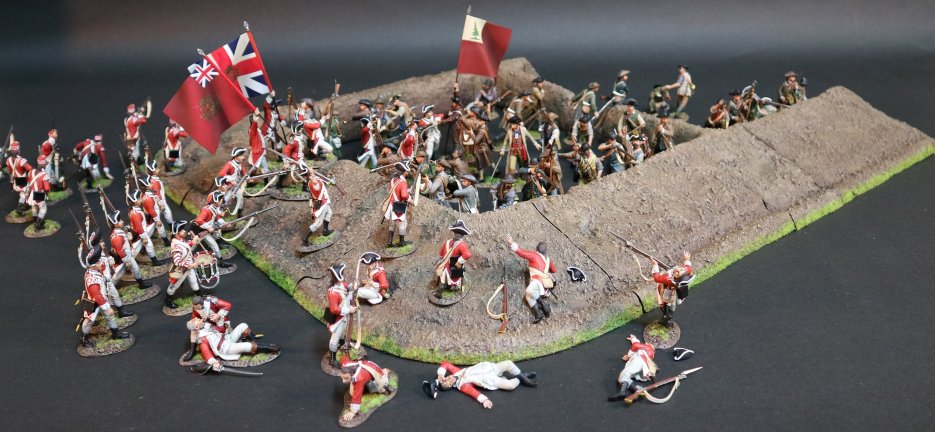
On the 16th June 1775, 3 detachments from Massachusetts regiments under the command of Colonel William Prescott and engineer Captain Richard Gridley, crossed the Charlestown neck and arrived at Bunker Hill.
Captain Richard Gridley and Prescott disagreed as to where they should locate their defense. Some work was performed on Bunker Hill, but Breed’s Hill was closer to Boston and viewed as being more defensible, and they decided to build their primary redoubt there.
Prescott and his men began digging a square fortification about 130 ft a side with ditches and earthen walls. The walls of the redoubt were about 6 feet high.
Work began at midnight, and around 4am one of the British warships spotted the earthworks on Breed’s Hill and opened fire.
The British command agreed that the works posed a significant threat, but were at this time sufficiently incomplete and isolated to offer a chance of a successful attack.
The original British plan was to bypass the redoubt to the north and capture Bunker’s Hill and the neck of the peninsula, thus isolating the redoubt on Breed’s Hill.
The Americans repulsed two British assaults, with significant British casualties. The British captured the redoubt on their third assault, after the defenders had run out of ammunition. The colonists retreated over Bunker Hill, leaving the British finally in control of the Peninsula.
The battle was a tactical victory for the British, but it proved to be a sobering experience for them; they incurred many more casualties than the Americans had sustained, including many officers. The battle had demonstrated that inexperienced militia were able to stand up to regular army troops in battle. Subsequently, the battle discouraged the British from any further frontal attacks against well defended front lines. American casualties were much fewer, although their losses included General Joseph Warren, and Major Andrew McClary, the final casualty of the battle.
BRITISH MARINES
The Marines, which only became “Royal Marines” in 1802, were the Royal Navy’s private army, administered by the Admiralty and controlled by senior naval officers. The rank and file were volunteers and wore army style uniforms and equipment. However they were trained to serve on warships and undertake amphibious operations. The 50 companies, shared between Chatham, Portsmouth and Plymouth, were not regimented, and detachments, or in some cases individual replacements were assigned on an ad hoc basis.
The first Marines sent to Boston were to form a battalion of 600 men under Major Pitcairn, but by March only 336 were present, as they soon became an object of inter service rivalry over pay, food and conditions. Although initially physically inferior to their army comrades, and short of essential equipment for service on land, incessant drilling and regular marches into the countryside soon created a fine unit.
Another group of over 700 men arrived in May, and the whole force formed two battalions, with grenadier and light companies.
The 1st and 2nd Marines were to play an important part in the assault on the southern defences of the Breed’s Hill redoubt.
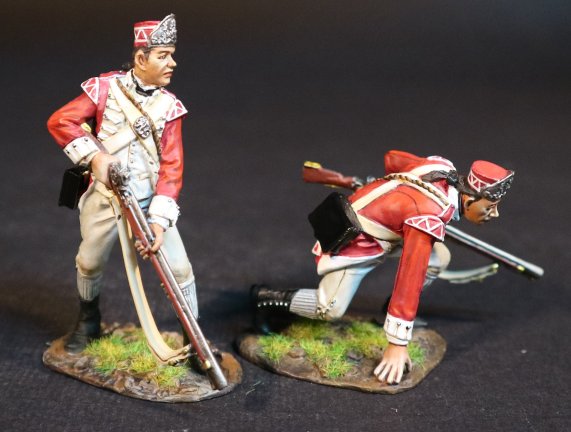
MBHL-21
THE AMERICAN WAR OF INDEPENDENCE 1775-1783,
THE BATTLE OF BUNKER HILL, JUNE 17th 1775,
THE ASSAULT ON THE REDOUBT AT BREED’S HILL,
BRITISH MARINES,
2 MARINE LIGHT INFANTRY
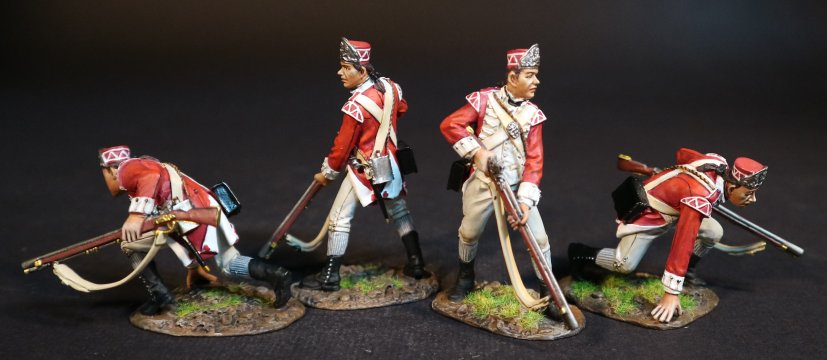
MBHL-21N
THE AMERICAN WAR OF INDEPENDENCE 1775-1783,
THE BATTLE OF BUNKER HILL, JUNE 17th 1775,
THE ASSAULT ON THE REDOUBT AT BREED’S HILL,
BRITISH MARINES,
4 MARINE LIGHT INFANTRY
THE BATTLE OF COWPENS, JANUARY 17th, 1781.
The Battle of Cowpens was an engagement during the American Revolutionary War fought on January 17th 1781, near the town of Cowpens, South Carolina, between American forces under Brigadier General Daniel Morgan, and British forces under Lieutenant Colonel Banastre Tarleton, as part of the campaign in the Carolinas.
The battle was a turning point in the American reconquest of South Carolina from the British.
Tarleton’s force of 1,000 British troops were set against 2,000 troops under Morgan. Morgan’s forces suffered casualties of only 25 killed and 124 wounded. Tarleton’s force was almost completely eliminated with almost 30% casualties and 55% of his force captured or missing, with Tarleton himself and only about 200 British troops escaping.
Morgan’s forces conducted a double envelopment of the British forces, the only double envelopment of the war.
CONTINENTAL LINE INFANTRY
THE DELAWARE COMPANY
The main core of Morgan’s flying Army was a battalion of veteran Continentals. Three companies of the Maryland Line, and one company from Delaware. These were highly trained and disciplined, and formed the main line commanded by John Eager Howard. They were the best troops to engage in prolonged close combat with British regulars.
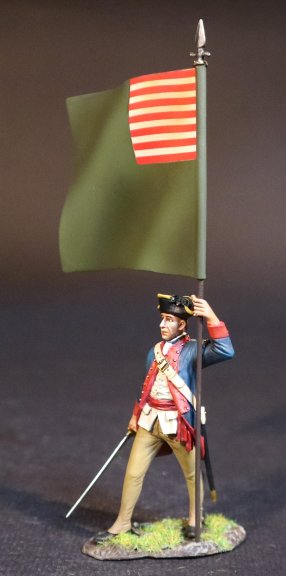
CWDEL-02
THE AMERICAN WAR OF INDEPENDENCE 1775 – 1783
THE BATTLE OF COWPENS, JANUARY 17th, 1781.
AMERICAN CONTINENTAL LINE INFANTRY,
THE DELAWARE COMPANY,
STANDARD BEARER
The Delaware Company was especially highly regarded, and most were survivors from the Battle of Camden. Their commander, Captain Robert Kirkwood, was also well regarded.
Their full regimental issued uniforms were dark blue with red facings, cuffs and turn backs. Waistcoats were white and more durable buckskins replaced the white cotton breeches, and they wore cocked hats trimmed with yellow braid.
A black metal cannister which held forty extra cartridges was also added.
In October 1780, North Carolina, from its meagre stores, furnished the men of the Delaware company with new shoes, a hunting shirt, and blue striped ticking overalls. This was the uniform worn at Cowpens and subsequent actions, at Guilford Court House, Hobkirk’s Hill, the Siege of Ninety Six and Eutaw Springs.
THE RAID ON ST. FRANCIS 1759
ROGER’S RANGERS

Roger’s Rangers was a company of soldiers form the Province of New Hampshire
raised by Major Robert Rogers and attached to the British Army during the Seven Year’s War (French and Indian War).
The unit was quickly adopted into the New England Colonies army as an independent ranger company. Rogers was inspired by colonial Frontiersman Ranger groups across North America and the teachings of unconventional warfare from Ranger such as Benjamin Church.
Robert Rogers trained and commanded his own rapidly deployable light infantry force , which was tasked mainly with reconnaissance as well as conducting special operations against distant targets.Their tactics were built on earlier Colonial precedents and were codified for the first time by Rogers as his 28 “Rules of Ranging”.
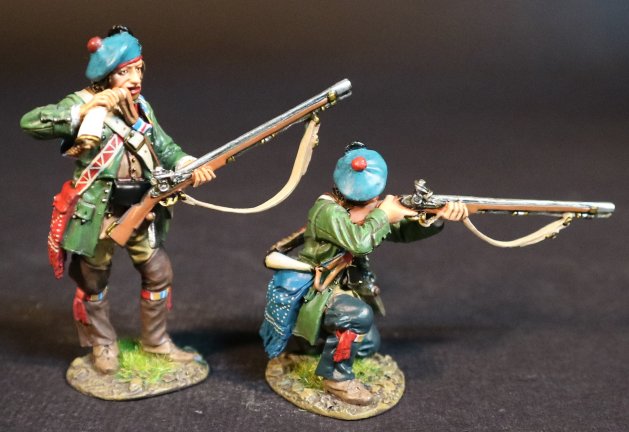
RR-30
THE EIGHTEENTH CENTURY COLLECTION
THE RAID ON ST. FRANCIS 1759,
ROGER’S RANGERS
The tactics proved remarkably effective, so much so that the initial company was expanded into a ranging corps of more than a dozen companies(containing as many as 1,200-1,400 men at its peak). The ranger corps became the chief scouting arm of British Crown forces by the late 1750s.The British forces in America valued Roger’s Rangers for their ability to gather intelligence about the enemy. They were disbanded in 1761.
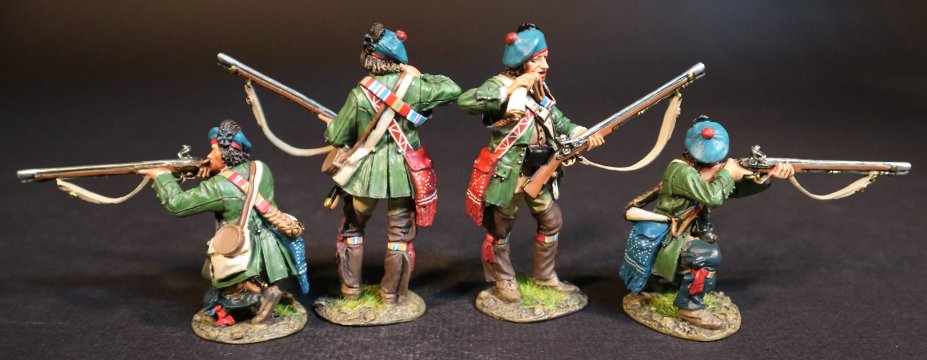
RR-30N
THE EIGHTEENTH CENTURY COLLECTION
THE RAID ON ST. FRANCIS 1759,
ROGER’S RANGERS
Contact your Dealer to pre-order today!
THE AMERICAN WAR OF INDEPENDENCE
THE BATTLE OF BUNKER HILL, 17th JUNE 1775.
THE ASSAULT ON THE REDOUBT AT BREED’S HILL
Boston was the third largest town in North America, and stood on a Peninsula connected to the mainland by a neck just wide enough to cross at high tide. The harbour, large enough to be strategically significant, and central to the town’s economy, was formed by a chain of islands stretching out to sea, guarded by reefs and ledges.
North west of Boston was Charlestown, a largely rural peninsula one and a half miles long. Charlestown stood at the south east corner with three hills behind it. Bunker’s Hill, nearest the neck of the Peninsula, Breed’s Hill 200 yards above the town and Moulton’s Hill to the north east.

On the 16th June 1775, 3 detachments from Massachusetts regiments under the command of Colonel William Prescott and engineer Captain Richard Gridley, crossed the Charlestown neck and arrived at Bunker Hill.
Captain Richard Gridley and Prescott disagreed as to where they should locate their defense. Some work was performed on Bunker Hill, but Breed’s Hill was closer to Boston and viewed as being more defensible, and they decided to build their primary redoubt there.
Prescott and his men began digging a square fortification about 130 ft a side with ditches and earthen walls. The walls of the redoubt were about 6 feet high.
Work began at midnight, and around 4am one of the British warships spotted the earthworks on Breed’s Hill and opened fire.
The British command agreed that the works posed a significant threat, but were at this time sufficiently incomplete and isolated to offer a chance of a successful attack.
The original British plan was to bypass the redoubt to the north and capture Bunker’s Hill and the neck of the peninsula, thus isolating the redoubt on Breed’s Hill.
The Americans repulsed two British assaults, with significant British casualties. The British captured the redoubt on their third assault, after the defenders had run out of ammunition. The colonists retreated over Bunker Hill, leaving the British finally in control of the Peninsula.
The battle was a tactical victory for the British, but it proved to be a sobering experience for them; they incurred many more casualties than the Americans had sustained, including many officers. The battle had demonstrated that inexperienced militia were able to stand up to regular army troops in battle. Subsequently, the battle discouraged the British from any further frontal attacks against well defended front lines. American casualties were much fewer, although their losses included General Joseph Warren, and Major Andrew McClary, the final casualty of the battle.
BRITISH MARINES
The Marines, which only became “Royal Marines” in 1802, were the Royal Navy’s private army, administered by the Admiralty and controlled by senior naval officers. The rank and file were volunteers and wore army style uniforms and equipment. However they were trained to serve on warships and undertake amphibious operations. The 50 companies, shared between Chatham, Portsmouth and Plymouth, were not regimented, and detachments, or in some cases individual replacements were assigned on an ad hoc basis.
The first Marines sent to Boston were to form a battalion of 600 men under Major Pitcairn, but by March only 336 were present, as they soon became an object of inter service rivalry over pay, food and conditions. Although initially physically inferior to their army comrades, and short of essential equipment for service on land, incessant drilling and regular marches into the countryside soon created a fine unit.
Another group of over 700 men arrived in May, and the whole force formed two battalions, with grenadier and light companies.
The 1st and 2nd Marines were to play an important part in the assault on the southern defences of the Breed’s Hill redoubt.

MBHL-21
THE AMERICAN WAR OF INDEPENDENCE 1775-1783,
THE BATTLE OF BUNKER HILL, JUNE 17th 1775,
THE ASSAULT ON THE REDOUBT AT BREED’S HILL,
BRITISH MARINES,
2 MARINE LIGHT INFANTRY

MBHL-21N
THE AMERICAN WAR OF INDEPENDENCE 1775-1783,
THE BATTLE OF BUNKER HILL, JUNE 17th 1775,
THE ASSAULT ON THE REDOUBT AT BREED’S HILL,
BRITISH MARINES,
4 MARINE LIGHT INFANTRY
THE BATTLE OF COWPENS, JANUARY 17th, 1781.
The Battle of Cowpens was an engagement during the American Revolutionary War fought on January 17th 1781, near the town of Cowpens, South Carolina, between American forces under Brigadier General Daniel Morgan, and British forces under Lieutenant Colonel Banastre Tarleton, as part of the campaign in the Carolinas.
The battle was a turning point in the American reconquest of South Carolina from the British.
Tarleton’s force of 1,000 British troops were set against 2,000 troops under Morgan. Morgan’s forces suffered casualties of only 25 killed and 124 wounded. Tarleton’s force was almost completely eliminated with almost 30% casualties and 55% of his force captured or missing, with Tarleton himself and only about 200 British troops escaping.
Morgan’s forces conducted a double envelopment of the British forces, the only double envelopment of the war.
CONTINENTAL LINE INFANTRY
THE DELAWARE COMPANY
The main core of Morgan’s flying Army was a battalion of veteran Continentals. Three companies of the Maryland Line, and one company from Delaware. These were highly trained and disciplined, and formed the main line commanded by John Eager Howard. They were the best troops to engage in prolonged close combat with British regulars.

CWDEL-02
THE AMERICAN WAR OF INDEPENDENCE 1775 – 1783
THE BATTLE OF COWPENS, JANUARY 17th, 1781.
AMERICAN CONTINENTAL LINE INFANTRY,
THE DELAWARE COMPANY,
STANDARD BEARER
The Delaware Company was especially highly regarded, and most were survivors from the Battle of Camden. Their commander, Captain Robert Kirkwood, was also well regarded.
Their full regimental issued uniforms were dark blue with red facings, cuffs and turn backs. Waistcoats were white and more durable buckskins replaced the white cotton breeches, and they wore cocked hats trimmed with yellow braid.
A black metal cannister which held forty extra cartridges was also added.
In October 1780, North Carolina, from its meagre stores, furnished the men of the Delaware company with new shoes, a hunting shirt, and blue striped ticking overalls. This was the uniform worn at Cowpens and subsequent actions, at Guilford Court House, Hobkirk’s Hill, the Siege of Ninety Six and Eutaw Springs.
THE RAID ON ST. FRANCIS 1759
ROGER’S RANGERS

Roger’s Rangers was a company of soldiers form the Province of New Hampshire
raised by Major Robert Rogers and attached to the British Army during the Seven Year’s War (French and Indian War).
The unit was quickly adopted into the New England Colonies army as an independent ranger company. Rogers was inspired by colonial Frontiersman Ranger groups across North America and the teachings of unconventional warfare from Ranger such as Benjamin Church.
Robert Rogers trained and commanded his own rapidly deployable light infantry force , which was tasked mainly with reconnaissance as well as conducting special operations against distant targets.Their tactics were built on earlier Colonial precedents and were codified for the first time by Rogers as his 28 “Rules of Ranging”.

RR-30
THE EIGHTEENTH CENTURY COLLECTION
THE RAID ON ST. FRANCIS 1759,
ROGER’S RANGERS
The tactics proved remarkably effective, so much so that the initial company was expanded into a ranging corps of more than a dozen companies(containing as many as 1,200-1,400 men at its peak). The ranger corps became the chief scouting arm of British Crown forces by the late 1750s.The British forces in America valued Roger’s Rangers for their ability to gather intelligence about the enemy. They were disbanded in 1761.

RR-30N
THE EIGHTEENTH CENTURY COLLECTION
THE RAID ON ST. FRANCIS 1759,
ROGER’S RANGERS
Contact your Dealer to pre-order today!



